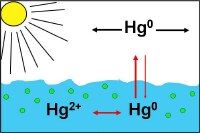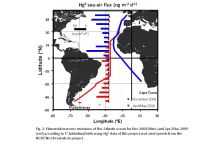
Measurement of the marine mercury emissions in the Atlantic (DFG)

Joachim Kuss, Hildegard Kubsch, Bernd Schneider (Antragsteller)
Mercury originates from natural sources and is additionally released to the environment by fossil fuel burning and industrial processes. As elemental mercury (Hg0) it is distributed globally, thereby slowly oxidized and then entrained into the sea by wet and dry deposition and by river drainage. But the sea also constitutes an important source of mercury(Selin et al., 2008). The transformation of ionic mercury to volatile Hg0 is possibly caused by abiotic photon-induced reactions and/or by biotic processes in surface waters. However the process is not well understood and Hg0 data is sparse to calculate the Hg0 sea-air gas exchange globally.
During transect of R/V “Polarstern” from Bremerhaven to Cape Town in November 2008 and from Punta-Arenas back to Bremerhaven in April/May 2009 Hg0 in surface waters as well as in the atmosphere and many co-parameter were measured (Kuss et al., 2009; Kuss et al., 2010). The Hg0 analyses of surface water (Hg0equ) were done each hour (about every 15 nautical miles) using an equilibrator coupled to a cold-vapour atomic fluorescence spectrometer. Alternately Hg0 is measured in the marine atmosphere (Hg0atm). The Hg0 sea-air flux (FHg0) was then calculated based on the measured concentration difference water-air and the gas exchange transfer velocity k that depends on wind speed, by using

by using the temperature dependent Henry’s law constant (H).

Strikingly high Hg0 concentrations were observed on both research cruises (Kuss et al., 2011)in the tropical Atlantic in the area of the intertropical convergence zone (ITCZ). This region is characterized by general low wind speeds and increased surface water temperatures. Moreover converging air masses lead to frequent tropical thunder storms and high precipitation amounts. Hence the prevailing conditions in the tropics seem ideal for mercury transformation: high wet deposition, intense solar radiation, a shallow mixed layer and low wind speeds that enable accumulation of Hg0. But the ITCZ is not strictly localized. It is moving north-south on a seasonal scale and even on a scale of several days the ITCZ shows meandering displacements from west to east across the Atlantic. Thus Hg0 accumulation areas are intermittently subjected to higher wind speeds and then show elevated emissions.
In the mid-latitudes a clear seasonality was found with strong Hg0 fluxes in autumn – November in the northern and May in the southern hemisphere, and low Hg0 fluxes in spring – November in the southern and May in the northern hemisphere. In conclusion, no relation between Hg0 and primary production (chlorophyll or pCO2) was found. However, based on our data a biotic contribution to the transformation by minor abundant algae or bacteria can’t be ruled out.
References
- Kuss, J., Kubsch, H., Wlost, K.-P. and Schneider, B., 2009. The expedition of the research vessel "Polarstern" to the Antarctic in 2008 (ANT-XXV/1): Elemental mercury sea-air flux. In: G. Kattner and B. Koch (Editors), Berichte zur Polar- und Meeresforschung - Reports on polar and marine research. Alfred Wegener Institute for Polar and Marine Research, Bremerhaven, pp. 31-34.
- Kuss, J., Kunze, M., Schneider, B., Wlost, K.-P. and Schulz-Bull, D.E., 2010. The expedition of the research vessel "Polarstern" to the Antarctic in 2009 (ANT-XXV/5): Elemental mercury sea-air flux. In: W. Zenk and S. El Naggar (Editors), Berichte zur Polar- und Meeresforschung - Reports on polar and marine research. Alfred Wegener Institute for Polar and Marine Research, Bremerhaven, pp. 41-45.
- Kuss, J., Zülicke, C., Pohl, C. and Schneider, B., 2011. Atlantic mercury emission determined from continuous analysis of the elemental mercury sea-air concentration difference within transects between 50° north and 50° south. Global Biogeochemical Cycles, 25: GB3021.
- Selin, N.E. et al., 2008. Global 3-D land-ocean-atmosphere model for mercury: Present-day versus preindustrial cycles and anthropogenic enrichment factors for deposition. Global Biogeochemical Cycles, 22: GB2011.
Description of the method
The method relies on the determination of Hg0 in air that is in equilibrium with surface seawater (Hg0equ). During the transect seawater is continuously pumped by a clean-seawater supply system into the ships lab and dispersed into the headspace of a 20 L glass bottle by a shower head. Permanently the water is drained close to the bottom of the bottle to keep a large volume of equilibrated air. The Hg0 water-air equilibrium is achieved in about one hour. The supply of the headspace gas to the analytical instrument without dilution or contamination by laboratory air is achieved by a raising water level in the equilibrator simply after closing the water drainage of the equilibrator. Subsequently Hg0 is measured in the equilibrated air using cold-vapour atomic fluorescence spectrometry after pre-concentration by gold amalgamation (Tekran 2537A). During times of equilibration, thus between the measurements of Hg0equ , air from an upper deck is supplied to the TEKRAN for the determination of the Hg0 concentration in the marine atmosphere (Hg0atm).